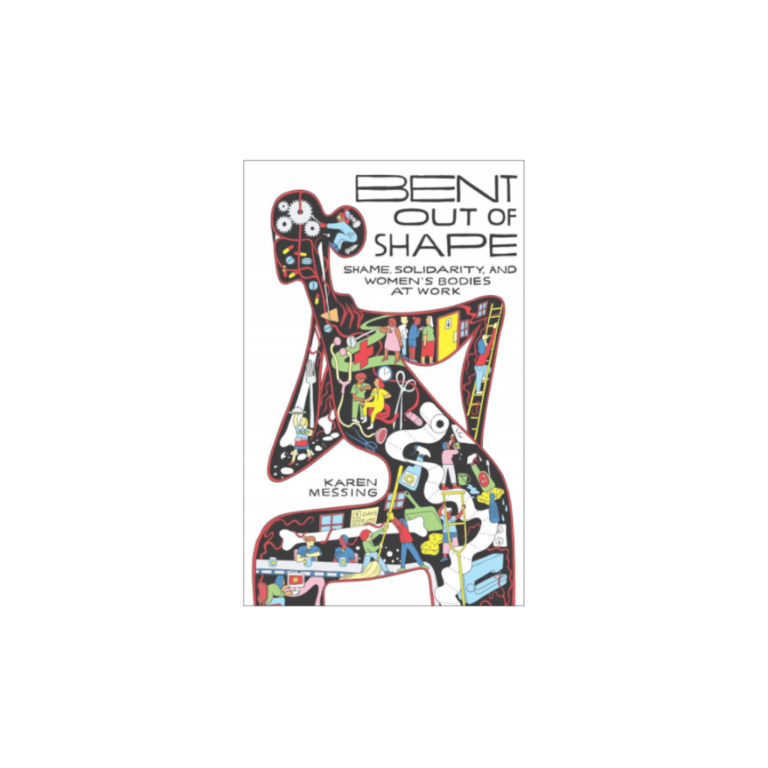Review of Bent Out of Shape: Shame, Solidarity, and Women’s Bodies at Work
Between the Lines Books. 2021. 276 pages.
If you’re anything like me, then all the word “ergonomics” brings to mind is mesh black chairs and stand-up desks that you wind up and down like an old car window crank. After reading Karen Messing’s Bent Out of Shape: Shame, Solidarity, and Women’s Bodies at Work, I learned that ergonomics is a field much more expansive than my limited “mesh chair, stand-up desk” perception allotted it. Bent Out of Shape reveals ergonomics — the study of the relationship between people and their working environments — as a fascinating, interdisciplinary field where science, law, and policy meet. Trained in ergonomics and genetics, Messing is a professor of biology at the Université du Québec à Montréal, where she conducts community research in women’s health, safety, and wellbeing at work.
In Bent Out of Shape, Messing takes the reader through a variety of such spaces: in between hospital beds, behind public toilets, within the attics of people’s homes, behind closed doors of university department meetings, over sewing machines, on maintenance trucks, and more. The book is about women’s bodies at work and, because bodies are socialized and policed, the social, legal, and political effects on women’s bodies in workspaces — spaces that are both physical and social.
The physical and social intersect in each of the studies Messing presents. In the very first chapter of the book, for instance, she writes of her work with communication technicians in Montreal. Through observing the women work, Messing found that, not only did they face situations that the men at the company did not, from the seemingly innocuous experience of having to negotiate entry into people’s homes and argue one’s qualifications, to enduring insults and sexist remarks, but they were also at higher risk of injury due to equipment ill-proportioned for most women’s bodies. The ladders were too long, harnesses too big, and belts too heavy.
When Messing asked some of the women at the company whether a cross-chest harness would make it easier to carry tools, they laughed: “Yeah sure, we’re going to have a strap coming across our front pushing our breasts out — we spend our whole day trying to make them forget we’re women.” The communications technicians study underscores the danger of the “forget we/they are women” attitude, whether that attitude is externally imposed or internalized.
My training in philosophy taught me to scrutinize terms. In reading a book about women’s work, I think: who is included in the category of “women”? In the preface, Messing writes that although all who identify as women experience workplace power imbalance, ignorance, sexism, and silencing, in the workplaces she has conducted her research, trans women and non-binary people have “not been visible.” Also in the preface, Messing extends what she terms an “apology” to racialized and immigrant workers, writing that she had not “had much opportunity to observe their work.”
Why trans, non-binary, racialized, and/or immigrant women workers were unavailable for Messing’s studies is a question left for further speculation. In the communications technicians study, for instance, five out of the ten women at the company came to the meeting with Messing and her research team. Who were the women not present at this meeting, and all the other meetings Messing writes of in Bent Out of Shape? What barriers might have stood in between those women and said meetings? These questions point to a gap in the category of “women” at the core of Bent Out of Shape that, while not willful, is significant.
To Messing’s credit, she is not afraid to admit that more work needs to be done. In the last chapter, “Going forward together,” Messing calls in community organizations and universities. Her employer, the Université du Québec à Montréal, is the only university in Canada that provides funding, personnel, and released time for professors to conduct community-based research and training. “And it is not because we haven’t tried to make the model known,” she writes, including her email address for any who wish to contact her for details. Chapter 12, “The technical is political,” includes two and half pages worth of (some) research questions that still need answering about women’s work, the inclusion of which seems, too, like an open call for researchers to take up the mantle.
Neither is Messing afraid to point to her own missteps, frankly writing about work that had not turned out how she had expected, even work that inadvertently harmed women. In her candor, Messing is a trustworthy voice in the struggle for better workspaces for women. Her writing is clear, direct, and accessible without being patronizing, and her action-orientedness and future-orientedness are compelling. Messing’s expertise, reflections, questions, and message are supported, too, by the book’s thoughtful design: well-structured chapters and subsections contain cogently presented charts and data, as well as typography that cleverly embodies the subject. Bent Out of Shape is nonfiction at its best: it informs, challenges, and scrutinizes the world but also itself.

